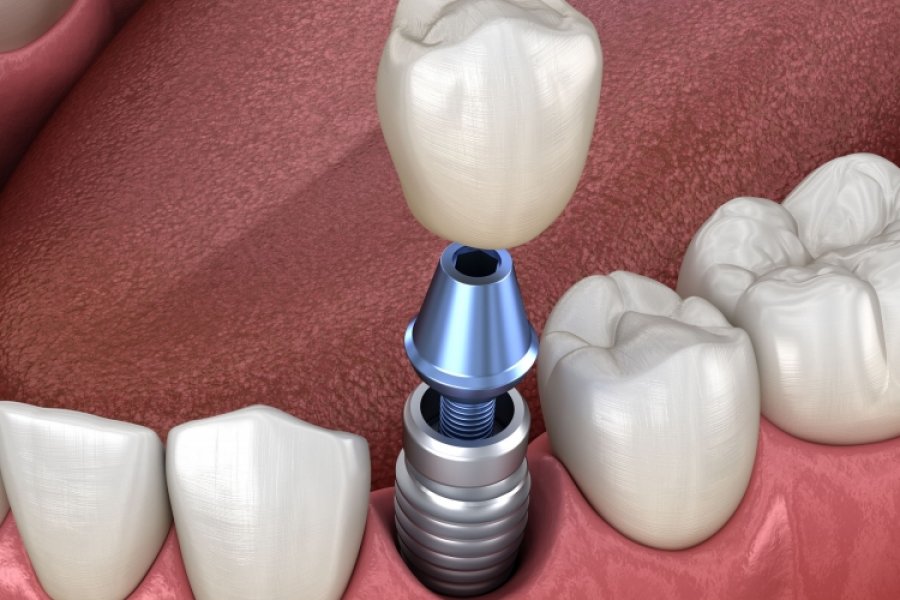How is the Implant Surgery Process?
- Istanbul Dental Clinlc
- How is the Implant Surgery Process?

How is the Implant Surgery Process?
Dental implants are oral prostheses that replace teeth that have been removed, extracted or damaged beyond repair. Implants replace both roots and teeth to restore a person's smile to healthy, normal function. Metal, screw-like posts made of titanium replace roots and are fused to the jawbone to form a solid foundation for artificial teeth or crowns.
Dental Implants
Missing or decayed teeth can pose a serious risk not only to your oral health but also to your overall health. An incomplete tooth can affect jaw alignment and function, affecting the way you chew, bite, speak and breathe. Misaligned or misaligned teeth in your mouth can put additional pressure on your neck and jaw muscles, causing headaches, facial pain, and broken teeth. In addition to increasing your risk of oral infections by creating an ideal space for bacteria, tooth gaps in the mouth can cause deterioration of the jawbone. When the jawbone shrinks and the gums recede, the teeth on either side of the cavity become weaker and more susceptible to decay. The teeth surrounding the gap can also shift towards the gap, leading to crooked or improperly spaced teeth. Missing teeth and poor oral health cause other general health problems such as heart disease, premature labour in women and endocarditis, an infection of the inner lining of the heart.
When should an implant be done?
Implant application is necessary in the following cases.
1. If one or more teeth are missing,
2. If you have healthy oral tissue,
3. If you have a growing chin,
4. If you do not want to wear dentures,
5. If you want to correct your speech,
If you are having problems with these 5 items mentioned above, dental implants are an important and valid reason for you to choose.
Implant Surgery
Although implant treatment is an outpatient procedure, it is a comprehensive process that takes several months and requires long periods for recovery. Although treatment times vary, the average implant procedure takes about six months.
Removal of damaged tooth or teeth
A bone graft is necessary if your jawbone is too soft or not thick enough to support the implant. A bone graft strengthens the jawbone and encourages new bone growth, creating a better, more stable foundation for the implant. Bone grafts can be natural, such as from another bone in your body, or made from a material that will provide the strength and structural support your jaw needs. To proceed with the implants, your jaw will need several months after grafting to heal and for enough new bone to grow. An incision is made in the gum to expose the bone into which holes are drilled to insert the implant posts. The post is inserted into the bone where it will act as a root. Although there is still a gap at this point, you have the option of a temporary prosthesis that can be removed for cleaning and sleeping. Osseointegration, the process by which living bone bonds to an artificial implant, begins when the titanium post is inserted into the jaw. Over the next few months, your jawbone will begin to grow on the surface of the implant, fusing with the implant to form a good foundation for your artificial tooth or teeth, just like natural teeth and roots.
An abutment is a piece that is attached to the top of the implant to support the crowns that will be placed. The attachment of the abutment means that it is attached to the implant and the gum tissue around the abutment
It requires a minor procedure where it is closed again, but not closed over, so that the gum line is still visible above it. Artificial teeth, also called crowns, are custom made to fit your mouth and match your natural teeth, but not until the implant has stabilised and the gums and jaw have healed from previous procedures. is not placed until the crown is fixed. Depending on your specific needs, your crowns can be fixed, removable or a combination of both. Removable teeth are similar to dentures. Implant is mounted on a metal frame that fits onto the abutment. Fixed teeth are permanently implanted screwed to the abutment.
Contact Us
You can contact us to get more detailed information about our treatments or you can send your questions to us via the contact form.
+38 220 334 087
City Kvart, Radoja Dakica Lamela 17/5 No:2 Podgorica Montenegro
Treatments
- Implant Treatment
- Personalized Implant
- Oral Diagnosis And Radiology
- T.M.J / Jaw Joint
- Cyst Operations (Surgery)
- Tooth Extraction
- Wisdom Teeth Extraction
- Smile Design
- Aesthetic Fillings (Composite)
- Laminate Veneers
- Zirconium Crowns
- Prosthetic Dentistry
- Orthodontics / Braces Treatment
- Teeth Whitening (Bleaching)
- Root Canal Treatment / Endodontics
- Gum Treatment (Periodontology)
- Pediatric Dentistry (Pedodontics)
- Orthodontics / Braces Treatment
- Prosthetic Dentistry
 English
English Türkçe
Türkçe